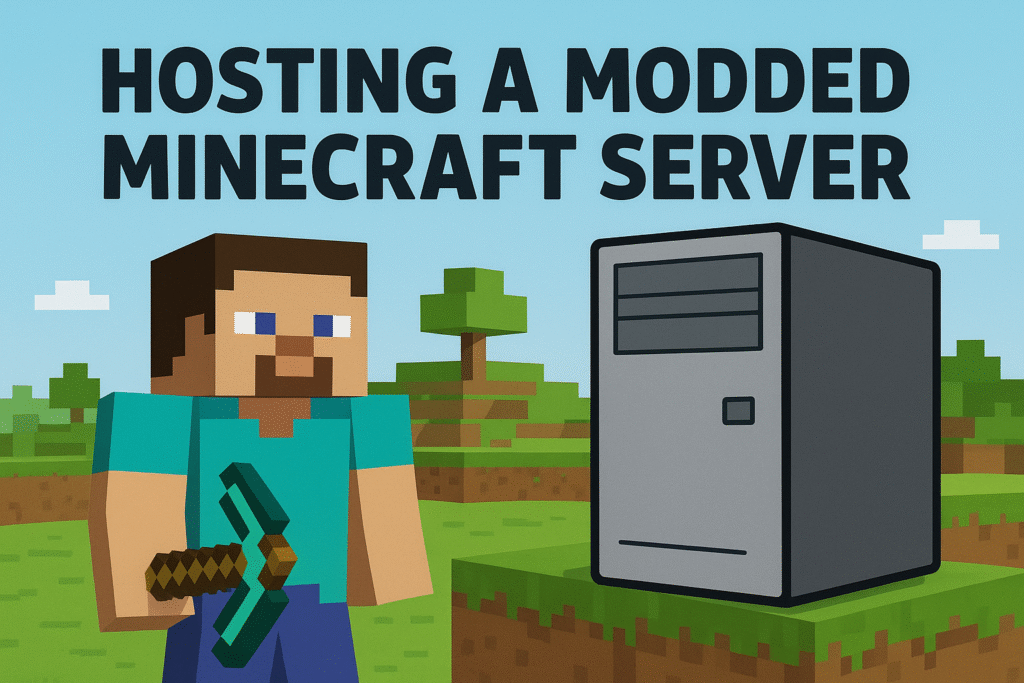Introduction
If you’ve ever played vanilla Minecraft, you know how fun it can be. But the real magic begins when you add mods—custom worlds, new creatures, magic systems, and game-changing plugins. That’s where hosting a modded Minecraft server comes in.
I’ve been hosting websites and game servers for over five years, managing domains, subdomains, and hosting plans. During this time, I’ve experimented with different providers and setups for Minecraft, especially for modded servers. In this article, I’ll share my experience and explain how to host your own modded Minecraft server, what role a subdomain plays, and which hosting options work best if you want smooth gameplay.
What Is a Modded Minecraft Server?
A modded Minecraft server is just like a regular server but with modifications (mods) installed. Mods can add new blocks, mobs, tools, and even completely new game mechanics. Unlike vanilla servers, modded servers need more resources—especially RAM, CPU, and storage—to run smoothly.
From my experience, the bigger the mod pack, the more demanding it is. A lightweight mod like OptiFine doesn’t require much, but something like RLCraft, Tekkit, or Feed the Beast (FTB) can eat up gigabytes of memory.
That’s why picking the right hosting setup is crucial.
Hosting Options: My Experience With Different Providers
Over the years, I’ve tried multiple hosting setups. Each has pros and cons depending on your budget and goals.
1. Self-Hosting on Your PC
When I first started, I hosted modded servers on my own computer. It worked fine with friends, but the problems were clear: lag, downtime, and my internet speed couldn’t handle multiple players. Plus, my PC had to be running all the time.
Good for learning, but not sustainable.
2. Shared Hosting for Minecraft
Then I moved to shared Minecraft hosting providers like Shockbyte and ScalaCube. They make things easy with one-click mod installations for packs like FTB, SkyFactory, or Pixelmon.
From my experience, shared hosting is best for casual communities (5–20 players). The main issue? You’re sharing hardware with other servers, so performance can fluctuate.
3. VPS (Virtual Private Server)
A VPS was my next step. Here, I rented a slice of a powerful server and configured everything myself. I had root access, which meant I could install any mods, plugins, or software.
This gave me more control but required technical knowledge. VPS hosting worked much better than shared hosting for larger mod packs and custom mod setups.
4. Dedicated Server Hosting
Eventually, I tested a dedicated server. With all resources dedicated only to my Minecraft world, performance skyrocketed. No lag, even with heavy mod packs and 30+ players online.
The downside is cost. Dedicated hosting is more expensive but worth it for big communities or content creators.
Why Subdomains Matter for Minecraft Hosting
One often-overlooked detail in hosting a server is how players connect. By default, players use your server IP address, like 192.168.0.1:25565. But let’s be honest—that’s not user-friendly.
This is where my experience with domains and subdomains became handy.
- Domain: A main website address, like mygamingcommunity.com.
- Subdomain: A child address under your main domain, like play.mygamingcommunity.com.
Instead of sharing a messy IP, I set up a subdomain:
👉 play.mydomain.com
Now, my friends could join easily, and it looked more professional. Plus, if I ever switched hosting providers, I just updated the DNS records without telling everyone a new IP.
For me, subdomains have been game-changers—not just for Minecraft, but for branding and SEO as well.
Steps to Host a Modded Minecraft Server (Based on My Setup)
Here’s the process I recommend after years of testing:
Step 1: Choose the Right Hosting Provider
- For small groups: shared hosting (Shockbyte, ScalaCube, ServerMiner).
- For larger communities: VPS or dedicated hosting.
- Consider location: pick a data center close to your players for low latency.
Step 2: Install Minecraft Forge or Fabric
Most mod packs require Forge or Fabric to run. Your hosting provider often has one-click installs, but if you’re on VPS/dedicated, you’ll need to set it up manually.
Step 3: Upload Your Mod Pack
Using FTP or the host’s control panel, upload your mods. Be sure everyone playing has the same version installed, or they’ll get kicked.
Step 4: Configure RAM Allocation
From experience, RAM is the most critical resource for modded servers.
- Light mods: 2–4GB RAM.
- Medium packs: 6–8GB RAM.
- Heavy packs (RLCraft, FTB): 10–16GB RAM.
Step 5: Use a Subdomain for Easy Access
Set up play.yourdomain.com so players never have to remember your IP. This also helps if you host multiple servers (skyblock.yourdomain.com, modpack.yourdomain.com).
Step 6: Optimize Performance
- Adjust server properties (view distance, tick speed).
- Install performance mods like SpongeForge or Paper.
- Regularly back up your world.
Common Mistakes I Learned to Avoid
Through trial and error, I ran into these pitfalls:
- Not enough RAM → lag, crashes.
- Forgetting backups → lost worlds.
- Mixing incompatible mods → server wouldn’t start.
- Ignoring subdomains → hard-to-remember IPs frustrated players.
Once I fixed these, my servers became far more stable and enjoyable.
Hosting Costs: What You Can Expect
From my 5 years of hosting, here’s a rough cost breakdown:
- Shared hosting: $5–$15/month
- VPS hosting: $10–$40/month
- Dedicated hosting: $80+/month
If you’re serious about running a large modded Minecraft community, VPS or dedicated hosting is worth the investment.
Final Thoughts
Hosting a modded Minecraft server isn’t just about renting space—it’s about creating a world where your community can thrive. From my personal journey, I learned that:
- Mods demand more resources than vanilla servers.
- Choosing the right host makes or breaks performance.
- A subdomain like play.mydomain.com makes your server professional and user-friendly.
After five years of testing providers and running my own setups, I can confidently say: if you want stability, go with a reliable Minecraft host and set up a proper domain and subdomain. That’s how you turn your modded world into a long-lasting community.
So, are you ready to launch your modded adventure? The right hosting plan—and a smart subdomain—will make all the difference.

